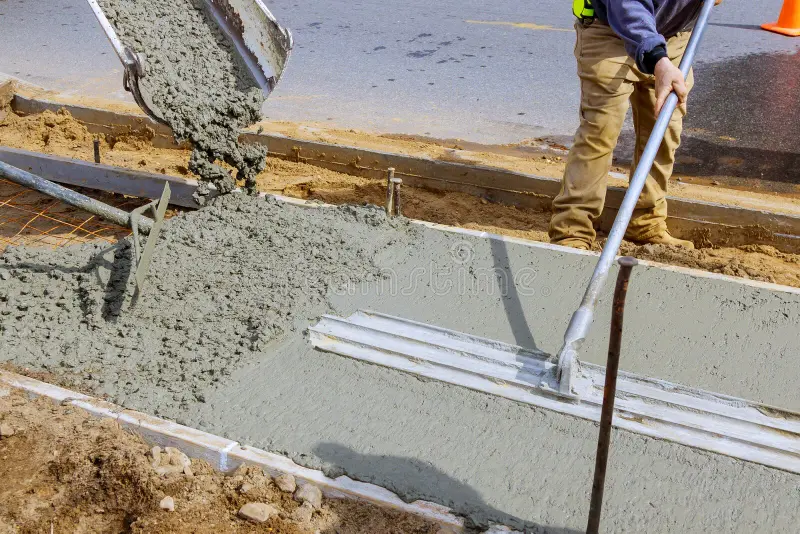You would need approximately 1.22 cubic yards (0.93 m³) of concrete for this small patio. At $125 per cubic yard, the concrete material alone would cost around $152.50.
2. Labor Costs (If You Hire a Professional)
If you were to hire a contractor, labor costs would make up a significant portion of your total expense. On average, professional concrete work costs between $8 to $18 per square foot, depending on the complexity of the job and your region. For a 100-square-foot patio, this could translate to $800 to $1,800 in labor costs alone.
By pouring your own concrete, you eliminate these labor costs, which is where the potential savings come into play. However, it’s essential to weigh these savings against the time and effort required to complete the project yourself.
3. Equipment Costs
Pouring concrete requires a variety of tools and equipment. If you’re doing it yourself, you may need to purchase or rent items like:
- Wheelbarrows
- Shovels
- Concrete mixers
- Leveling tools (screeds, trowels, etc.)
- Rebar or mesh for reinforcement
- Concrete forms (typically wooden boards)
These tools can range in cost. A wheelbarrow, for instance, might cost $50 to $100, while renting a concrete mixer could run you $50 to $150 per day. Depending on the size of your project, these costs can add up quickly, so it’s crucial to factor them into your budget.
Advantages of Pouring Your Own Concrete
There are several compelling reasons why homeowners might choose to pour their own concrete rather than hiring a contractor:
1. Cost Savings
As mentioned earlier, the primary advantage of a DIY concrete project is the potential for cost savings. Eliminating labor expenses can significantly reduce the overall price of the project. If you already own or can borrow some necessary tools, this further reduces your costs.
For example, a contractor might charge $2,500 to $3,500 to install a 300-square-foot concrete patio. By doing it yourself, you might be able to complete the project for around $1,200 to $1,500, depending on the cost of materials and equipment rental.
2. Control Over the Project
When you pour your own concrete, you have complete control over the timeline and the quality of the work. This can be a significant advantage for homeowners who want to customize their project or ensure that high-quality materials are used.
3. Learning New Skills
Taking on a DIY concrete project can be a valuable learning experience. For homeowners interested in home improvement, gaining skills in concrete work can open the door to future projects, saving even more money down the road.
Drawbacks of Pouring Your Own Concrete
Despite the potential savings, there are several drawbacks to consider when pouring your own concrete.
1. Time and Effort
Concrete work is labor-intensive and time-sensitive. Once the concrete is mixed, you have a limited amount of time (typically about 60 to 90 minutes) to pour and finish it before it begins to harden. For large projects, this can be physically demanding and stressful, especially if you’re working with a small crew or by yourself.
2. Risk of Mistakes
Concrete is a permanent material, and mistakes can be costly. If the ground is not properly prepared, or if the concrete isn’t mixed and poured correctly, you could end up with cracks, uneven surfaces, or weak spots. Fixing these issues may require costly repairs or even starting the project over from scratch.
3. Weather Conditions
The weather plays a significant role in concrete work. Ideally, concrete should be poured when the temperature is between 50°F and 60°F, and rain should be avoided at all costs during the curing process. If you’re not experienced in working with concrete, it can be challenging to plan around weather conditions, which could delay the project or result in poor-quality concrete.
Step-by-Step Guide to Pouring Your Own Concrete
If you’ve weighed the pros and cons and decided to pour your own concrete, here’s a basic step-by-step guide to help you get started:
1. Planning and Preparation
Before beginning, take the time to plan your project. Determine the size and depth of the concrete slab, calculate the amount of concrete you’ll need, and gather all the necessary materials and tools.
2. Site Preparation
Start by clearing the area where the concrete will be poured. Remove any grass, rocks, or debris, and ensure the ground is level. For most projects, you’ll need to dig down several inches to create space for the concrete and any gravel or reinforcement you plan to use.
Next, create a form to contain the concrete. This is typically done with wooden boards placed around the perimeter of the project area. Secure the boards with stakes, making sure they are level.
3. Add a Gravel Base
A layer of gravel provides a stable base for the concrete and helps with drainage. Spread about 2 to 4 inches of gravel over the area and use a compactor to ensure it is evenly distributed and packed tightly.
4. Reinforcement (Optional)
For larger projects or areas that will bear heavy loads (like driveways), it’s a good idea to add reinforcement in the form of rebar or wire mesh. This will help prevent cracking and improve the strength of the finished slab.
5. Mixing the Concrete
If you’re using bagged concrete mix, follow the instructions on the packaging to mix the concrete. You can do this in a wheelbarrow or, for larger projects, a rented concrete mixer. Aim for a consistency that is workable but not too wet.
6. Pouring the Concrete
Once the concrete is mixed, start pouring it into the form. Use a shovel or rake to spread the concrete evenly, filling in all the corners and edges. As you pour, work quickly to prevent the concrete from setting before you’re finished.
7. Leveling and Finishing
After the concrete is poured, use a screed (a long, straight board) to level the surface. Move the screed back and forth over the surface in a sawing motion, making sure the concrete is level and smooth.
Next, use a trowel to smooth the surface of the concrete further. If you want to add texture (such as a broom finish), do so before the concrete fully sets.
8. Curing the Concrete
Concrete needs to cure slowly to reach its full strength. Cover the concrete with plastic sheeting or keep it moist by misting it with water periodically over the next few days. Avoid walking or placing heavy objects on the concrete during this time.
Final Thoughts: Is Pouring Your Own Concrete Cheaper?
Pouring your own concrete installation can be a cost-effective option, especially for smaller projects or homeowners who are comfortable with DIY tasks. However, the potential savings must be balanced against the time, effort, and risk of mistakes involved.
For a small patio or walkway, doing the work yourself could save you hundreds or even thousands of dollars. But for larger or more complex projects, the labor and expertise of a professional might be worth the additional cost to ensure a high-quality, long-lasting result.
Ultimately, the decision comes down to your experience level, the size of the project, and your willingness to invest the time and effort required to get the job done right.

